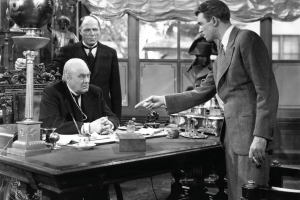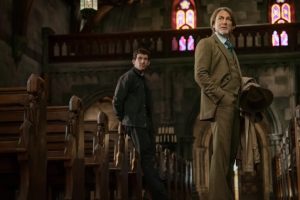A new release from Boston-area novelist Jennifer Haigh ponders questions of causality and randomness in the lives of ordinary people striving for meaning in a seemingly “oblivious” cosmos. Rabbit Moon (Little, Brown and Company), released this April, describes the tribulations of a contemporary American family whose iconoclastic daughter disappears for a new life in Shanghai.
Notions of happenstance, the passage of time, and the impact of fate and circumstance in our lives occur frequently in Haigh’s writing canon. As the author explains in a recent series of interviews, the Rabbit Moon story is a meditation on randomness. The story concludes with these words: “the mechanism is impartial, constant as clockwork—a disinterested metronome, ticking off time.” Rabbit Moon does not suggest that “everything” in life is random, however, only that random things do happen, and they have consequences in our lives.
Haigh often writes about families, brothers and sisters constrained by such uncontrollable factors as economic class, geography, the physical environment, and resignation to a dreary sameness. Most of her protagonists are Catholics who, while not always remaining firm in their devotion, grapple with notions of personal sin, suffering, grace, and the possibility of redemption.
Unescapable Catholicism
The author was born and raised in Barnesboro, Pennsylvania, a “small-town America” community dependent on coal mining for its economic survival. Noted for its Catholic churches, company-built houses, and ravaged landscape, Barnesboro’s downtown core—as noted wistfully by a local website—“still has some life left in it.” A front-end Gen Xer, Haigh is the author of seven novels and a short-story collection. Many critics note her sympathetic character development and keen insights into family dynamics.
As the daughter of traditional Catholic parents who attended Mass weekly and always said grace before meals, Haigh readily admits that Catholicism “seeps into everything” she puts on paper. “Catholicism was so central to my upbringing that I’m incapable of writing a character without thinking about his relationship to religion,” Haigh says. “Even my most secular characters are defined in some way by their understanding of the divine.”
Her debut novel, Mrs. Kimble (2003), outlines the lives and experiences of three women who, over a 25-year timeframe, marry the same charming but deceitful man. Mrs. Kimble garnered the 2004 PEN Hemmingway Award for best debut novel, the first of several literary awards the writer has collected over the two decades since then. While Mrs. Kimble isn’t replete with overtly Catholic themes and content, it is an early expression of the author’s concern for ordinary characters’ submission to random chance, and circumstance.
Grappling with contradictions
The Catholic influence on Haigh’s oeuvre is most apparent in the 2011 novel Faith. Completed just a few years after the frenzy and disillusionment of the priestly abuse scandals, Faith explores the case of Father Arthur Breen, a committed but old-school Boston-area priest who is accused of child molestation. Father Breen’s half-sister Sheila, who never quite understood Breen’s lifelong aspiration to the priesthood, tells the story in retrospect. As Father Breen struggles to prove his innocence and return to regular pastoral work, he comes to understand the contradictions of priestly celibacy and the basic human need to give and receive love.
This novel also explores the issue of an institutional, tradition-bound church that resists change and often protects its reputation and authority at the expense of more meaningful pastoral care. Haigh raises even more disturbing questions about celibacy and its impact on priests’ spiritual, psychological, and simple human development. As Sheila reflects at the end of the book, “Holy Mother [Church] . . . has been a negligent parent. She has failed to protect those in her care. Like many people, I have wondered: is celibacy to blame? That renunciation of human closeness, of our deepest instincts: is it, in the end, simply too much to ask?”
The 2015 work Mercy Street, a story of pro- and anti-abortion clashes at a Boston-area women’s clinic, examines some gray areas in the right-to-life struggle—an unavoidable doctrine for all committed Catholics. Told primarily from the viewpoint of Claudia, an early-middle-aged counselor at the Mercy Street clinic, the book manages to elicit sympathy for both vulnerable young women and girls dealing with unwanted pregnancies, as well as the pro-life picketers who earnestly believe their faith compels them to put abortion clinics out of business.
Although the abortion debate drives the narrative tension in Mercy Street, the book also presents a compelling counterargument to the judgmental attitudes toward “fallen women.” In Haigh’s imagination, these women are too readily dismissed as perpetuators of their own suffering and misfortune, as described by the intake worker Claudia: “My fault . . . Over the years, Claudia had heard the same words from teenagers and middle-aged women; from nurses and teachers, cops and soldiers; sex workers and rape victims and survivors of incest. It was a lesson they’d been taught from birth, swallowed and digested: at all times, in all circumstances, the woman was to blame.”
In many ways, Haigh’s character Claudia forces readers to think beyond rigid pro-life certainties. The story tells us: “Like many poor people, [Claudia] had been raised by a teenager. Years later, working on Mercy Street, she would meet her ‘mother’ every day—pregnant girls in extremis, half-educated, without resources. Adolescents charged with the monumental task of raising a human being and being utterly unqualified for the job.”
A practice of empathy
For Haigh, writing and reading novels is an exercise in extreme empathy. “I often write characters with whom I disagree,” she says. “I have to, since without conflict there is no story. What I try to do is write characters the way they’d write themselves, with all their convictions and blind spots.”
The author’s ability to get inside the hearts and minds of her characters is especially apparent in Mercy Street. Pro-life picketers, for example, are capable of kindness and concern for women seeking abortion, while clinic staff are presented as sincere advocates for vulnerable women in extreme distress. “Given my background, I had a heightened awareness of the controversy over abortion,” Haigh says. “I’d been hearing about the evils of abortion since elementary school, long before anyone bothered to explain how a woman actually got pregnant.”
For Haigh, “Catholic conundrums”—such as clerical celibacy or the church’s position on contraception, gay marriage, and abortion—can leave believers at odds with the imperative to love our neighbor. “This comes up again and again in my work, particularly in Faith and Mercy Street,” Haigh says. “As a Catholic, I find it hard to square this reality with the church’s position on contraception and abortion, and this moral conflict comes up often in my work.”
Compressed by living
Another recurring theme in Haigh’s work is the near futility of ordinary people constrained by factors such as place, circumstance, and gender. Women characters especially come up short in terms of opportunity and personal growth when compared with male figures. A pair of Haigh novels, Baker Towers (2005) and Heat and Light (2016) emphasize her concern for setting as something that sets limits on people’s lives. Even the physical environment seems to affect a protagonist’s outlook and attitude.
Set in the fictional town of Bakerton, Baker Towers describes the hardscrabble lives of coal miners in rural Pennsylvania, where Haigh spent most of her childhood. The fictional Bakerton is a place “where slowly, invisibly, it made [its residents] smaller, compressed by living where little was possible, where the ceiling was so very low.”
In Baker Towers, Haigh paints compassionate word pictures of ordinary women in small communities that depend on coal mining or other declining industries. One such scenario has young women longing to be married at age 18 simply to avoid a life of near poverty and stagnation: “Their hard lives—the brutish husband, the endless succession of babies—seemed to swallow them completely; and those, everyone knew, were the success stories. No one spoke of the girls who stood on the altar six months pregnant, or the young mining widows left with more children than any sane woman could have wanted in the first place.”
The same type of decaying community forms the settling for Heat and Light, which envisions the disruption in the lives of a small Pennsylvania town due to power companies’ fracking to scrounge for natural gas deposits.
Earthbound
With these two novels, Haigh makes a compelling case that the natural environment should be treated as a gift rather than as something to be exploited for energy supply and wealth. “I consider care of the environment a duty of all humans,” Haigh says. “I grew up in a town very much like Bakerton, where extractive industry was the entire basis of the local economy, so I have a heightened awareness of the environmental devastation it can cause.”
It’s clear that “place” is determinative in much of Haigh’s fictional canon. “For most of us,” she says, “this is the Appalachian experience—an almost crippling attachment to our homeplace. Some of my characters are so rooted that they’re unable to function anywhere else. In a small town where everyone is interconnected and everyone knows your history, you are always someone, no matter how unremarkable you may otherwise be. Other characters find this suffocating and are desperate to leave but remain haunted by the place that made them.”
Essentially, Haigh’s creative gaze is more earthbound than heavenly. The author pines for her characters to live their lives with fewer disruptions from this world’s contradictions, mysteries, and anxieties. While her characters have some control over their lives and decisions, they continue to struggle against thwarted ambition, diminished opportunity, and the subtle oppression that gender, class, and social stigma impose. While religious faith is present among Haigh’s protagonists, it often offers more questions than certainties.
Image: Courtesy of Beowulf Sheehan












Add comment